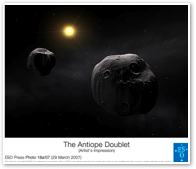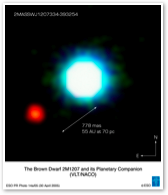A Science Machine
The Impossible Siblings
Combining precise observations obtained by ESO’s Very Large Telescope with those gathered by a network of smaller telescopes, astronomers have described in unprecedented detail the double asteroid Antiope, which is shown to be a pair of rubble-pile chunks of material, of about the same size, whirling around one another in a perpetual pas de deux. The two components are egg-shaped despite their very small sizes.
Read more in the original news story
Exploding Stars at the Edge of the Universe
Gamma-Ray Bursts (GRBs) are bursts of highly energetic gamma rays lasting from less than a second to several minutes – the blink of an eye on cosmological timescales. They are known to occur at huge distances from Earth, towards the limits of the observable Universe. Such bursts occur when a massive star explodes or when two very dense objects merge.
The VLT has observed the afterglow of a Gamma-Ray Burst that is the farthest known ever. With a measured redshift of 6.3, the light from this very remote astronomical source has taken 12.8 billion years to reach us. It is thus seen when the Universe was less than 900 million years old, or less than seven per cent its present age. It must have released 300 times as much energy in a few seconds as our Sun will in its entire lifetime of more than 10 billion years. GRBs are therefore the most powerful explosions in the Universe since the Big Bang.
Read more in the original news story

First Image of an Extrasolar Planet
Using NACO on the VLT, astronomers detected a faint and very red point of light, very near a brown dwarf object designated 2M1207. The feeble object is more than 100 times fainter than 2M1207 and its near-infrared spectrum, obtained with great efforts, shows the signatures of water molecules. Further observations over a period of one year convincingly demonstrate that the two objects are bound. This is thus the first image of a 5 Jupiter-mass planet in orbit around 2M1207.
Read more in the original news story

Read more ESO discoveries in the ESO Press Releases
